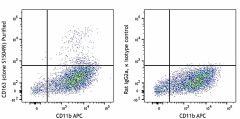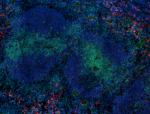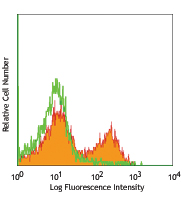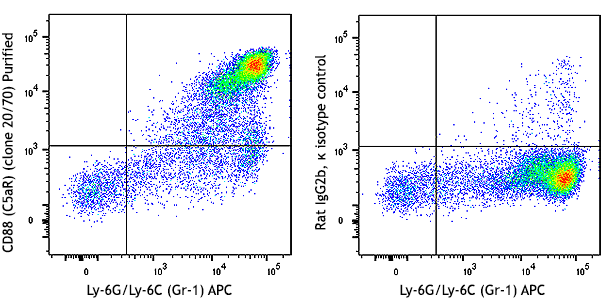- Clone
- S15049I (See other available formats)
- Regulatory Status
- RUO
- Other Names
- M130, MM130, SCARI1
- Isotype
- Rat IgG2a, κ
- Ave. Rating
- Submit a Review
- Product Citations
- publications

-

C57BL/6 mouse peritoneal macrophages were cultured for seven days in the presence of Dexamethasone, then stained with CD11b APC and purified CD163 (clone S15049I, left), or purified rat IgG2a, κ isotype control (right), followed by PE Goat anti-rat IgG antibody. -

C57BL/6 bone marrow were stained with CD11b APC and purified CD163 (clone S15049I, left), or purified rat IgG2a, κ isotype control (right), followed by PE Goat anti-rat IgG antibody. Data shown was gated on total bone marrow cells. -

C57BL/6 mouse frozen spleen section was fixed with 4% paraformaldehyde (PFA) for ten minutes at room temperature and blocked with 5% FBS for 30 minutes at room temperature. Then, the section was stained with 10 µg/mL of Purified anti-mouse CD163 Antibody (clone S15049I) overnight at 4°C. On the next day, the tissue was washed twice with PBS and stained with Alexa Fluor® 594 anti-rat IgG (clone Poly4054, red) and CD3e (clone 500A2) Alexa Fluor® 647 (green) for two hours at room temperature. The image was captured with a 10X objective. -

C57BL/6 mouse frozen liver section was fixed with 4% paraformaldehyde (PFA) for ten minutes at room temperature and blocked with 5% FBS for 30 minutes at room temperature. Then, the section was stained with 10 µg/mL of Purified anti-mouse CD163 Antibody (clone S15049I) overnight at 4°C. On the next day, the tissue was washed twice with PBS and stained with Alexa Fluor® 594 anti-rat IgG (clone Poly4054, red) for two hours at room temperature. The image was captured with a 10X objective.
| Cat # | Size | Price | Quantity Check Availability | Save | ||
|---|---|---|---|---|---|---|
| 155302 | 500 µg | 235€ | ||||
CD163 is a member of the group B scavenger receptor cysteine-rich superfamily, also known as GHI/61, M130, RM3/1, p155, hemoglobin-haptoglobin complex receptor, or macrophage-associated antigen. It is a 134 kD (non-reduced)/155 kD (reduced) glycoprotein primarily expressed on macrophages, Kupffer cells, monocytes, a subset of dendritic cells, and a subset of hematopoietic stem/progenitor cells. CD163 binds to haptoglobin-hemoglobin complex and TWEAK, and plays a role in clearing hemoglobin and regulating cytokine production by macrophages. Membrane CD163 can be cleaved by metalloproteinases (MMP), resulting in a soluble form. Elevated serum level of sCD163 has been implicated in many kinds of inflammatory diseases.
Product DetailsProduct Details
- Verified Reactivity
- Mouse
- Antibody Type
- Monoclonal
- Host Species
- Rat
- Immunogen
- Recombinant mouse CD163 extracellular domain
- Formulation
- Phosphate-buffered solution, pH 7.2, containing 0.09% sodium azide.
- Preparation
- The antibody was purified by affinity chromatography.
- Concentration
- 0.5 mg/ml
- Storage & Handling
- The antibody solution should be stored undiluted between 2°C and 8°C.
- Application
-
FC - Quality tested
IHC-F - Verified - Recommended Usage
-
Each lot of this antibody is quality control tested by immunofluorescent staining with flow cytometric analysis. For flow cytometric staining, the suggested use of this reagent is ≤ 0.125 µg per million cells in 100 µL volume. For immunohistochemistry on frozen tissue sections, a concentration range of 5 - 10 µg/mL is suggested. It is recommended that the reagent be titrated for optimal performance for each application.
- Product Citations
-
- RRID
-
AB_2734239 (BioLegend Cat. No. 155302)
Antigen Details
- Structure
- Type 1 transmembrane glycoprotein, 134 kD (non-reduced)/155 kD (reduced) glycoprotein
- Distribution
-
Macrophages, Kupffer cells, monocytes, a subset of dendritic cells, and a subset of hematopoietic stem/progenitor cells
- Function
- Binds to haptoglobin-hemoglobin complex and TWEAK, and plays a role in clearing hemoglobin and regulating cytokine production by macrophages
- Biology Area
- Immunology
- Molecular Family
- CD Molecules
- Gene ID
- 93671 View all products for this Gene ID
- UniProt
- View information about CD163 on UniProt.org
Related Pages & Pathways
Pages
Related FAQs
Other Formats
View All CD163 Reagents Request Custom Conjugation| Description | Clone | Applications |
|---|---|---|
| Purified anti-mouse CD163 | S15049I | FC,IHC-F |
| Brilliant Violet 421™ anti-mouse CD163 | S15049I | FC |
| PE anti-mouse CD163 | S15049I | FC |
| APC anti-mouse CD163 | S15049I | FC |
| TotalSeq™-A0417 anti-mouse CD163 | S15049I | PG |
| TotalSeq™-B0417 anti-mouse CD163 | S15049I | PG |
| TotalSeq™-C0417 anti-mouse CD163 | S15049I | PG |
| PE/Dazzle™ 594 anti-mouse CD163 Antibody | S15049I | FC |
| KIRAVIA Blue 520™ anti-mouse CD163 Antibody | S15049I | FC |
| PE/Cyanine7 anti-mouse CD163 Antibody | S15049I | FC |
| APC/Fire™ 810 anti-mouse CD163 Antibody | S15049I | FC |
| APC/Cyanine7 anti-mouse CD163 | S15049I | FC |
| Brilliant Violet 711™ anti-mouse CD163 | S15049I | FC |
| Brilliant Violet 605™ anti-mouse CD163 | S15049I | FC |
| Alexa Fluor® 647 anti-mouse CD163 | S15049I | FC |
Customers Also Purchased
Compare Data Across All Formats
This data display is provided for general comparisons between formats.
Your actual data may vary due to variations in samples, target cells, instruments and their settings, staining conditions, and other factors.
If you need assistance with selecting the best format contact our expert technical support team.
-
Purified anti-mouse CD163

C57BL/6 mouse peritoneal macrophages were cultured for seven... 
C57BL/6 bone marrow were stained with CD11b APC and purified... 
C57BL/6 mouse frozen spleen section was fixed with 4% parafo... 
C57BL/6 mouse frozen liver section was fixed with 4% parafor... -
Brilliant Violet 421™ anti-mouse CD163

C57BL/6 bone marrow were stained with CD11b APC and CD163 Br... -
PE anti-mouse CD163

C57BL/6 bone marrow were stained with CD11b APC and CD163 (c... -
APC anti-mouse CD163

C57BL/6 bone marrow cells were stained with CD11b PE and CD1... -
TotalSeq™-A0417 anti-mouse CD163
-
TotalSeq™-B0417 anti-mouse CD163
-
TotalSeq™-C0417 anti-mouse CD163
-
PE/Dazzle™ 594 anti-mouse CD163 Antibody

C57BL/6 mouse bone marrow cells were stained with CD11b APC ... -
KIRAVIA Blue 520™ anti-mouse CD163 Antibody

C57BL/6 mouse bone marrow cells were stained with CD11b APC ... -
PE/Cyanine7 anti-mouse CD163 Antibody

C57BL/6 mouse bone marrow cells were stained with CD11b APC ... -
APC/Fire™ 810 anti-mouse CD163 Antibody

C57BL/6 mouse bone marrow cells were stained with anti-mouse... -
APC/Cyanine7 anti-mouse CD163

C57BL/6 mouse bone marrow cells were stained with anti-mouse... -
Brilliant Violet 711™ anti-mouse CD163

C57BL/6 mouse bone marrow were stained with anti-mouse CD11b... -
Brilliant Violet 605™ anti-mouse CD163

C57BL/6 bone marrow cells were stained with anti-mouse CD11b... -
Alexa Fluor® 647 anti-mouse CD163

C57BL/6 bone marrow cells were stained with anti-mouse CD11b...
 Login / Register
Login / Register 












Follow Us